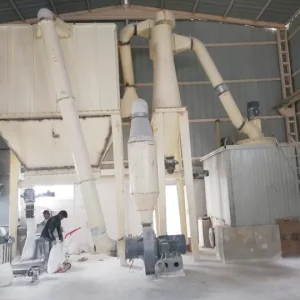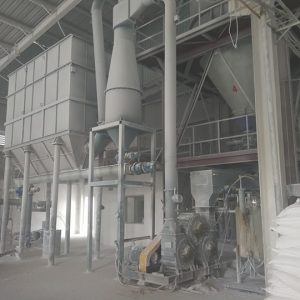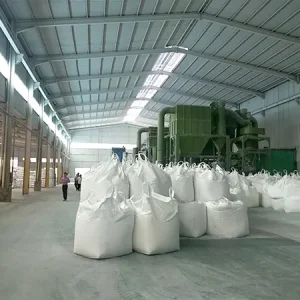Карбонат кальция — это широко используемое минеральное соединение с различными промышленными применениями. Для удовлетворения спроса на тонкоизмельченный карбонат кальция были разработаны передовые технологии измельчения. Одной из таких технологий является вертикальная валковая мельница для карбоната кальция. В этой статье представлено углубленное исследование вертикальной валковой мельницы для карбоната кальция, обсуждаются ее определение, принципы работы, преимущества и недостатки.
Определение и принципы работы:
Вертикальная валковая мельница для карбоната кальция — это специализированное оборудование, предназначенное для измельчения и переработки карбоната кальция в мелкий порошок. Она состоит из вертикальной роликовой системы, которая вращается вокруг своей оси, что обеспечивает эффективное и точное измельчение материала. Исходный материал карбоната кальция подается через центральное входное отверстие, а центробежная сила, создаваемая вращающимися роликами, измельчает материал на измельчающем столе или дорожке. В результате частицы карбоната кальция тонко измельчаются и классифицируются для достижения желаемого распределения размеров частиц.
Преимущества вертикальных валковых мельниц для карбоната кальция:
- Высокая эффективность измельчения: вертикальные валковые мельницы используют комбинацию сил сжатия и сдвига для эффективного измельчения частиц карбоната кальция. Процесс измельчения осуществляется в ограниченном пространстве, что обеспечивает тщательное измельчение и снижение потребления энергии.
- Улучшенный контроль размера частиц: вертикальные валковые мельницы обеспечивают превосходный контроль над распределением размера частиц молотого карбоната кальция. Регулируемая скорость ротора, давление измельчения и настройки классификатора позволяют точно контролировать и настраивать размер частиц конечного продукта.
- Широкий спектр применения: вертикальные валковые мельницы для карбоната кальция могут обрабатывать различные типы карбоната кальция, включая как природные, так и синтетические формы. Они подходят для измельчения материалов с различной степенью твердости, влажности и абразивности.
- Сокращение требований к техническому обслуживанию: Вертикальные валковые мельницы имеют относительно простую конструкцию и меньше движущихся частей по сравнению с традиционными мельницами. Это приводит к снижению потребностей в техническом обслуживании, сокращению простоев и снижению сопутствующих расходов.
- Компактная конструкция: Вертикальные валковые мельницы обычно имеют компактную площадь основания, что делает их подходящими для установок с ограниченным пространством. Их можно легко интегрировать в существующие производственные линии или использовать как отдельные устройства.
Недостатки вертикальных валковых мельниц с карбонатом кальция:
- Первоначальные инвестиционные затраты: Первоначальные инвестиционные затраты на вертикальную валковую мельницу для карбоната кальция относительно выше по сравнению с другим оборудованием для измельчения. Однако долгосрочные выгоды и экономия средств, достигнутые за счет повышения эффективности и сокращения технического обслуживания, могут компенсировать эти первоначальные инвестиции.
- Ограниченная возможность грубого помола: Вертикальные валковые мельницы в первую очередь предназначены для тонкого и сверхтонкого помола. Они могут иметь ограничения в эффективном помоле крупных частиц из-за характера их принципов работы и конструктивных особенностей. Для обработки крупных частиц могут потребоваться дополнительные этапы измельчения или альтернативное оборудование.
- Чувствительность к характеристикам материала: Определенные свойства материала, такие как твердость, влажность и абразивность, могут влиять на производительность вертикальных валковых мельниц для карбоната кальция. Для достижения желаемых результатов измельчения определенных материалов могут потребоваться оптимальные рабочие параметры и регулировки.
- Потенциальная перегрузка системы: в случаях, когда исходный материал содержит примеси или твердые частицы, существует риск перегрузки системы вертикальной валковой мельницы. Это может привести к снижению эффективности измельчения, повышенному износу оборудования и потенциальным сбоям в производстве.
Вертикальная валковая мельница из карбоната кальция предлагает несколько преимуществ, включая высокую эффективность измельчения, улучшенный контроль размера частиц, широкий диапазон применения, сниженные требования к техническому обслуживанию и компактную конструкцию. Однако важно учитывать первоначальные инвестиционные затраты, ограниченную возможность грубого измельчения, чувствительность к характеристикам материала и потенциальную перегрузку системы. Понимание этих преимуществ и недостатков помогает оценить пригодность и экономическую целесообразность вертикальной валковой мельницы из карбоната кальция для конкретных применений измельчения.
- Кольцевая валковая мельница для сухого помола карбоната кальция
- В чем разница между вертикальной мельницей и кольцевой валковой мельницей?
- Что такое вертикальная валковая мельница для производства карбоната кальция?
- Раскрытие потенциала кольцевой валковой мельницы: революционное решение для эффективной обработки материалов
- Как каолин влияет на механические свойства резины


